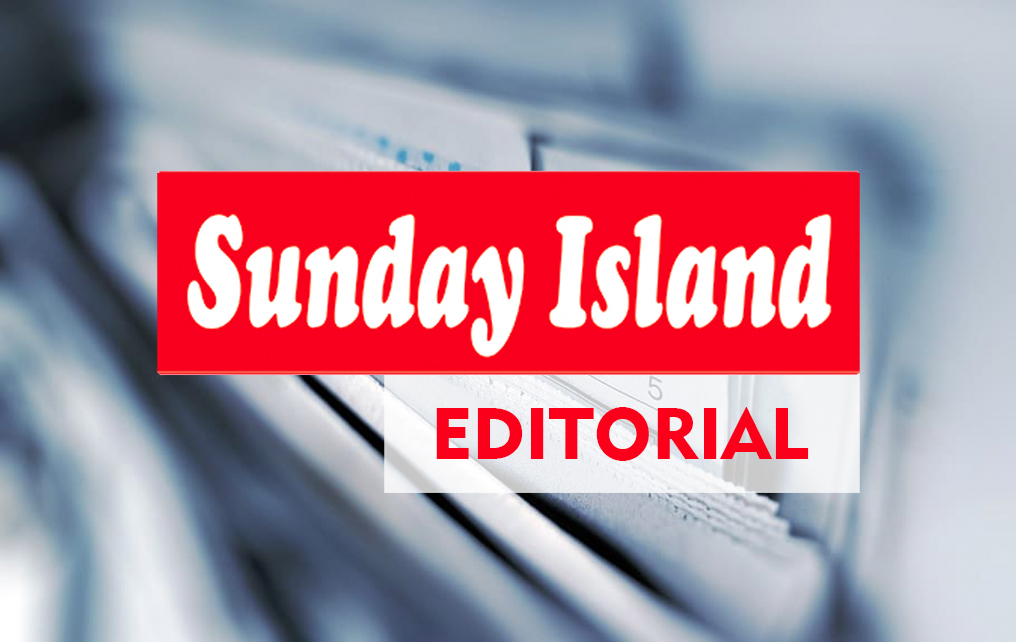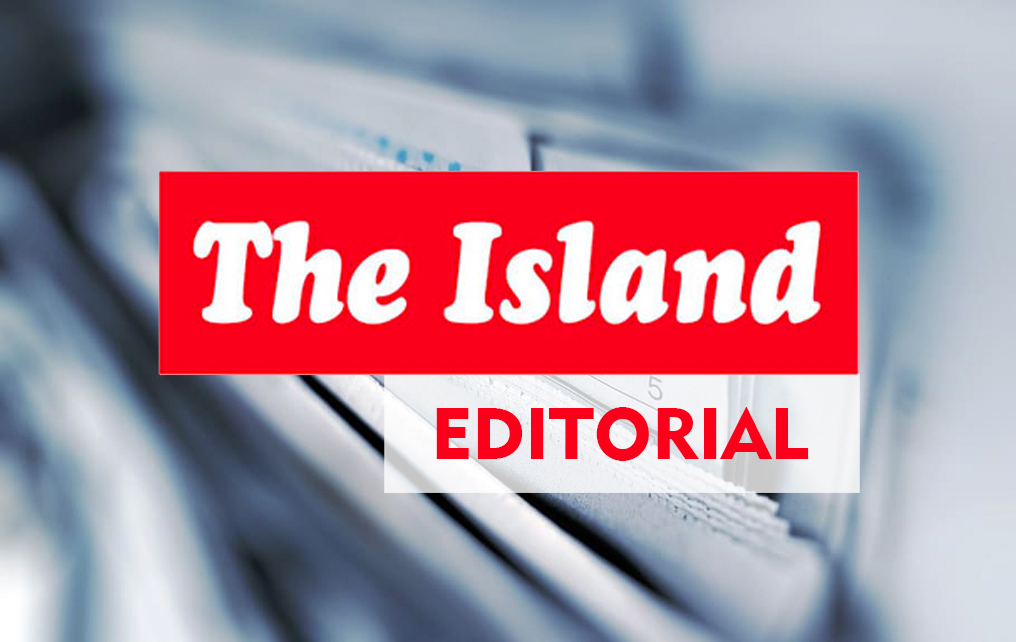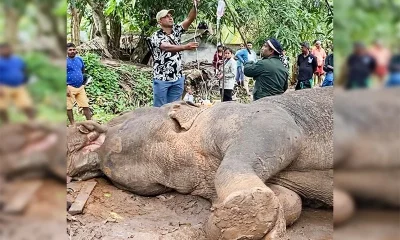Editorial
Sanath Nishantha

The death on Thursday of State Minister Sanath Nishantha on the Katunayake expressway when his luxury sports utility vehicle (SUV) crashed headlong into the back of a container carrier in the early hours of the morning generated the predictable publicity in the evening news bulletins of the various television stations and Friday’s newspapers.
What caused the accident which killed Nishantha and his police security guard and injured his driver has not been definitively revealed as this is being written. There was a later report that the driver who had not been seriously hurt has been arrested and a statement recorded. He had allegedly been driving at a very high speed when the crash occurred. This raises questions on police inaction over dangerously driven VIP vehicles.
Nishantha apparently had attended two weddings in Kurunegala and Chilaw and was on his way back to his official residence in Colombo when the accident happened. His family had attended the function at Kurunegala while he had gone without them to Chilaw. Thursday evening’s television news provided extensive coverage of the accident including images of the clearing of the wreckage from the scene and condolence visits by President Ranil Wickremesinghe and former President Mahinda Rajapaksa among others to Nishantha’s Colombo residence.
Rajapaksa spoke glowingly of the late state minister saying his death was a great loss to the party and to the nation. Readers may remember that it was Nishantha who settled an unpaid electricity bill incurred on the occasion of Namal Rajapaksa’s wedding.
The body lay at a funeral parlour in the city prior to their removal for interment at Aratchikatuwa, the home base of the Puttalam district parliamentarian who was serving his second term in the legislature. He had previously served as a provincial councilor and been a member of a local body. Many members of the ruling party and others paid their respects. The late Nishantha, incidentally, was one of the many ruling party politicians whose homes/offices were attacked and destroyed after a mob from ‘Temple Trees’ set upon the Aragalaya protesters on Galle Face.
It has been alleged that he was one of the leaders of this attack. His political history is replete with many violent incidents and various social media references to his demise were less that complimentary. This angered some of his political colleagues prompting them to say such references were proof of the need to have some controls over social media.
On the flip side were other points of view with a former member of the Human Rights Commission, Ambika Sathkunanathan, taking to Instagram to claim many connections between public reaction to the politician’s death (such as cheering, references to karma etc.) and impunity, lack of respect for the rule of law and the inability of people to obtain redress for abuse of power and rights violations.
“In societies where the state and politicians are predators and public institutions do not function to serve the public, when someone who has abused power, used violence and acted with impunity suffers a loss or is killed, people see that as punishment and/or justice,” she said. Some readers would remember there was lighting of firecrackers celebrating President Premadasa’s assassination, a clear indication of certain social values that persist in this country.
The vacancy in the legislature caused by the death of the state minister will not go to the Sri Lanka Podu Jana Peramuna (SLPP) but to Wimal Weerawansa’s breakaway group which contested the last parliamentary election under the SLPP banner. This is on account of the number of preferential votes polled by Jagath Priyankara who topped the preference vote count of unelected candidates in the Puttalam district.
ITAK/TNA
Last week’s election of a new leader of the Ilankai Thamil Arasu Katchi (ITAK) which leads the Tamil National Alliance (TNA), widely regarded as the most formidable of the Tamil political formations, saw the defeat of front runner Mathiaparanam Abraham Sumanthiran, PC, MP, by fellow Jaffna district parliamentarian T. Shritharan who soon after his victory visited the LTTE cemetery triggering unease about a possible return to Tamil extremism.
Although what was originally slated to be a three-cornered contest, eventually became a battle between Shritharan and Sumanthiran and the finish was not even close with the former winning comfortably. The third candidate who withdrew fom the race threw his weight behind the winner whose supporters say had the backing of a formidable section of the Tamil diaspora.
Sumathiran, an accomplished civil, constitutional and human rights lawyer, first entered the legislature through the National List of his party but was later able to secure election from the Jaffna district. Demonstrating considerable political and debating skills, he is among the outstanding frontbenchers of the incumbent legislature. Academic Dayan Jayatilleka who is a respected political analyst, said in a column last week that he had hoped that Sumanthiran, “a sophisticated post-war parliamentarian” he was rooting for, would have won the race – “but that’s democracy and the autonomous choice of a community.”
The new leadership of the TNA in an election year assumes special importance. President Ranil Wickremesinghe has been working towards achieving minority support for his candidature and has established contact with the diaspora. When President JR Jayewardene first stood for election as president, Mr. Kumar Ponnabalam also ran finishing fourth behind Hector Kobbekaduwa and Rohana Wijeweera but ahead of Dr. Colvin, R. de Silva. Kobbekaduwa won a considerable number of Jaffna votes attributed to the high prices that onions and chillies commanded during Mrs. Bandaranaike’s United Front government when scarcities were endemic.
Whether there would be a Tamil candidate this time round or whether the Tamil parties would back a main contender is yet an open question. The JVP is throwing considerable effort to organize itself in the North and East. These are yet early days and how events will play out remains to be seen.
Editorial
Misplaced priorities

Sri Lanka has a very ‘promising’ government and a perennially protesting Opposition. The government makes various promises, which are like piecrusts made to be broken. The Opposition in a perpetual state of agitation bursts into protests at the drop of a hat. The two sides have been clashing in Parliament instead of sinking their political differences and cooperating at least in the aftermath of a disaster.
The Opposition has requested Speaker Dr. Jagath Wickramaratne to appoint a Parliamentary Select Committee (PSC) to probe the government’s alleged failure to mitigate the impact of Cyclone Ditwah despite repeated warnings issued by the Meteorology Department and the Irrigation Department. The government is determined to avoid a fate similar to that which befell the Yahapalana government following the Easter Sunday terror attacks, which became the undoing of that dysfunctional regime. It is therefore very unlikely to meet the Opposition’s demand at issue. Even if it agrees to appoint a PSC to probe its own alleged lapses, by any chance, it will not allow an Opposition MP to chair the committee and will go all out to frustrate its rivals’ efforts to ruin its political future.
Interestingly, some of the key Opposition members are former Yahapalana MPs who sought to derail a PSC probe into the 2015 Treasury bond scam. They craftily appointed a member of the JVP, which was a Yahapalana partner in all but name, as the Chairman of that PSC, and incorporated a slew of footnotes into the committee report in a bid to dilute it.
In this country, PSCs rarely help get to the bottom of the issues they probe. The PSC on the Treasury bond scam went out of its way to clear the then Prime Minister Ranil Wickremesinghe’s name, and helped the UNP scapegoat former Central Bank Governor Arjuna Mahendran and throw him to the wolves. In 2012, Mahinda Rajapaksa government turned a PSC probe into a witch-hunt against then Chief Justice Dr. Shirani Bandaranayake, who was subsequently wrongfully impeached. The PSC that investigated the Easter Terror attacks (2019) gathered a lot of valuable information but its findings, conclusions and recommendations were tainted by a glaring political bias.
Going by the government’s determined bid to let its MP Asoka Ranwala off the hook, following a road accident, how ruthless the JVP-led NPP will be in warding off threats to its political survival is not difficult to imagine. The Opposition can go on shouting until it is blue in the face but it will not be able to have the government’s alleged failure to heed disaster warnings and save lives investigated properly as long as the JVP/NPP is in power.
What we are witnessing on the political front, especially in Parliament, is like a drunken brawl at a funeral. The government and the Opposition are fighting while the country is mourning those who perished in recent floods and landslides.
What the political parties represented in Parliament ought to do at this juncture is to get their priorities right. They must stop clashing and make a concerted effort to carry out post-disaster rebuilding operations and strengthening the economy. They must not lose sight of the rapid depreciation of the rupee, and the disconcerting forecasts of an economic slowdown. The much-advertised revenue bubble, created by an unprecedented increase in vehicle imports, is about to burst, and the possibility of the country having a rupee crisis to contend with again cannot be ruled out. Foreign reserve targets are far from achieved, and there is a pressing need to boost the forex inflow and ensure that the country will be able to honour its pledge to resume foreign debt repayment in 2028.
All political parties have done precious little for the disaster victims. They have been only visiting the welfare centres and distributing relief materials collected from the considerate public. They ought to engage in post-disaster rebuilding actively. Reconstruction is a labour-intensive task. The self-righteous political leaders should mobilise their community level organisation for post-disaster rebuilding. Sadly, they have not even helped clean flood-hit houses.
Editorial
Cops as whipping boys?

Saturday 20th December, 2025
Disciplinary action has reportedly been taken against several police officers for their alleged failure to conduct a proper investigation into a recent accident caused by NPP MP Asoka Ranwala in Sapugaskanda. This move, we believe, has the trappings of a diversionary tactic. The police would have incurred the wrath of the government if they had conducted a breathalyzer test on Ranwala and produced him before a Judicial Medical Officer immediately after the crash where an infant, his mother and grandmother were injured.
Ranwala was subjected to a blood alcohol test more than 12 hours after the accident, according to media reports. The police would not have dragged their feet of their own volition. They were obviously made to do what they did. The law applies equally only to ordinary people. Will the police top brass explain why no disciplinary action was taken against the police officers who unashamedly sided with a group of JVP members involved in grabbing an office of the Frontline Socialist Party (FSP) in Yakkala in September 2025. After turning a blind eye to that blatant transgression, the police provided security to the JVP members who were forcibly occupying the FSP office. Thankfully, a judicial intervention made them leave the place. The current rulers claim they have not placed themselves above the law, unlike their predecessors. A wag says they have placed the law below them instead!
Having made a mockery of its much-advertised commitment to upholding the rule of law by intervening to prevent Ranwala from undergoing an alcohol test immediately after the aforesaid accident, the government is making attempts at face-saving. Curiously, blood samples obtained from Ranwala have been sent to the Government Analyst for testing! The government seems to have a very low opinion of the intelligence of the public, who voted for it overwhelmingly, expecting a ‘system change’.
It is being argued in some quarters that the disciplinary inquiry against the police officers has been scripted, and the charges against them will be dropped when the issue fizzles out. This argument is not without some merit, but there is a possibility of the government going to the extent of trying to clear its name at the expense of the police officers concerned if push comes to shove.
Successive governments have scapegoated police personnel and other state employees to safeguard their interests, and the incumbent administration is no exception; it has already sought to shift the blame for its failure to mitigate the impact of Cyclone Ditwah to the Meteorological Department, which, it has claimed, did not warn it about the extreme weather events fairly in advance. Opposition Leader Sajith Premadasa told Parliament on Thursday that the government had muzzled some senior officials of the Meteorological Department.
Some leaders of the incumbent government are bound to face legal action for their commissions and omissions when they lose power, and the state officials pandering to their whims and fancies will have to do likewise.
The public officials who are at the beck and call of politicians and carry out illegal orders should realise that they run the risk of being left without anyone to turn to in case they have to face legal action for their transgressions. Their ruthlessly self-seeking political masters will not scruple to sacrifice them.
Editorial
Disaster relief mired in dirty politics

Friday 19th December, 2025
Opposition Leader Sajith Premadasa has accused the government of interfering with the ongoing disaster relief programmes. Speaking in Parliament, on Thursday, he produced what he described as documentary proof to support his claim that disaster victims were required to have their applications for compensation endorsed by the heads of the Prajashakthi committees controlled by the JVP apparatchiks. Several other Opposition MPs have levelled the same allegation against the government in Parliament.
Two trade unions representing the Grama Niladharis have complained of political interference with their work, and even threatened to pull out of the disaster relief programmes unless they are allowed to carry out their duties and functions, free from political pressure.
Sri Lanka United Grama Niladhari Association (SLUGNA) President Nandana Ranasinghe told the media on 08 December that JVP/NPP politicians and their supporters were meddling with the disaster relief programmes at all levels and even obstructing the Grama Niladharis (GNs). He claimed that the political authority had sent letters to the District and Divisional Secretaries, directing them to appoint JVP/NPP members to the state-run welfare centres. SLUGNA Secretary Jagath Chandralal said state officials had been directed to obtain approval from the government members of the Prajashakthi committees for carrying out relief work. A few days later, addressing the media, Convenor of the Sri Lanka Grama Niladhari Association Sumith Kodikara also made a number of similar allegations. He said the NPP politicians were arbitrarily helping their supporters obtain Rs. 25,000 each as compensation. He stressed that only the disaster victims had to be paid compensation, and never had disaster relief programmes been politicised in that manner. These allegations are shocking enough to warrant probes, as we said in a previous comment.
Initially, the government denied the involvement of its Prajashakthi members in the process of selecting disaster relief beneficiaries, but now it allows them to work alongside state officials openly. This is an instance of the arrogance of power, which became the undoing of several previous governments, especially the ones led by the UNP and the SLPP. Minister K. D. Lal Kantha has gone on record as claiming that the Prajashakthi functionaries too should have a say in relief provision!
Funds the government is distributing among disaster victims belong to the state, and therefore no political party must be allowed to influence or control their disbursement. One can argue that it is prima facie unlawful for anyone other than authorised public officials to get involved in the process of distributing state funds as disaster relief. The Opposition should find out whether there is any legal provision for the involvement of the Prajashakthi functionaries in relief distribution or whether they are committing a transgression.
The government is apparently labouring under the mistaken belief that it can use disaster relief to shore up its approval rating as well as electoral prospects in view of the next election––the Provincial Council polls which it is coming under increasing pressure to hold next year. Political interference with disaster relief only exasperates the public beyond measure. A large number of disaster victims have held protests in several areas, claiming that they have been overlooked.
The JVP/NPP, which came to power promising to depoliticise the state institutions and revitalise the public service, should be ashamed of having stooped so low as to politicise the process of providing disaster relief. Politicians have a sense of shame only when they are out of power.
If the JVP/NPP leaders are wise, they will learn from the predicament of the Rajapaksas, who had to pay a heavy price for testing the patience of the public. The latter had to head for the hills with angry people in close pursuit. Now that the people have successfully got rid of a bunch of failed rulers, they may take to the streets again if their patience runs out. The government would do well to follow the established procedures in carrying out disaster relief programmes, without subjugating them to its political agenda and undermining their integrity.
-

 Midweek Review5 days ago
Midweek Review5 days agoHow massive Akuregoda defence complex was built with proceeds from sale of Galle Face land to Shangri-La
-

 News4 days ago
News4 days agoPope fires broadside: ‘The Holy See won’t be a silent bystander to the grave disparities, injustices, and fundamental human rights violations’
-

 News4 days ago
News4 days agoPakistan hands over 200 tonnes of humanitarian aid to Lanka
-

 News5 days ago
News5 days agoBurnt elephant dies after delayed rescue; activists demand arrests
-

 Business3 days ago
Business3 days agoUnlocking Sri Lanka’s hidden wealth: A $2 billion mineral opportunity awaits
-

 Editorial5 days ago
Editorial5 days agoColombo Port facing strategic neglect
-

 News3 days ago
News3 days agoArmy engineers set up new Nayaru emergency bridge
-

 News5 days ago
News5 days agoSri Lanka, Romania discuss illegal recruitment, etc.













